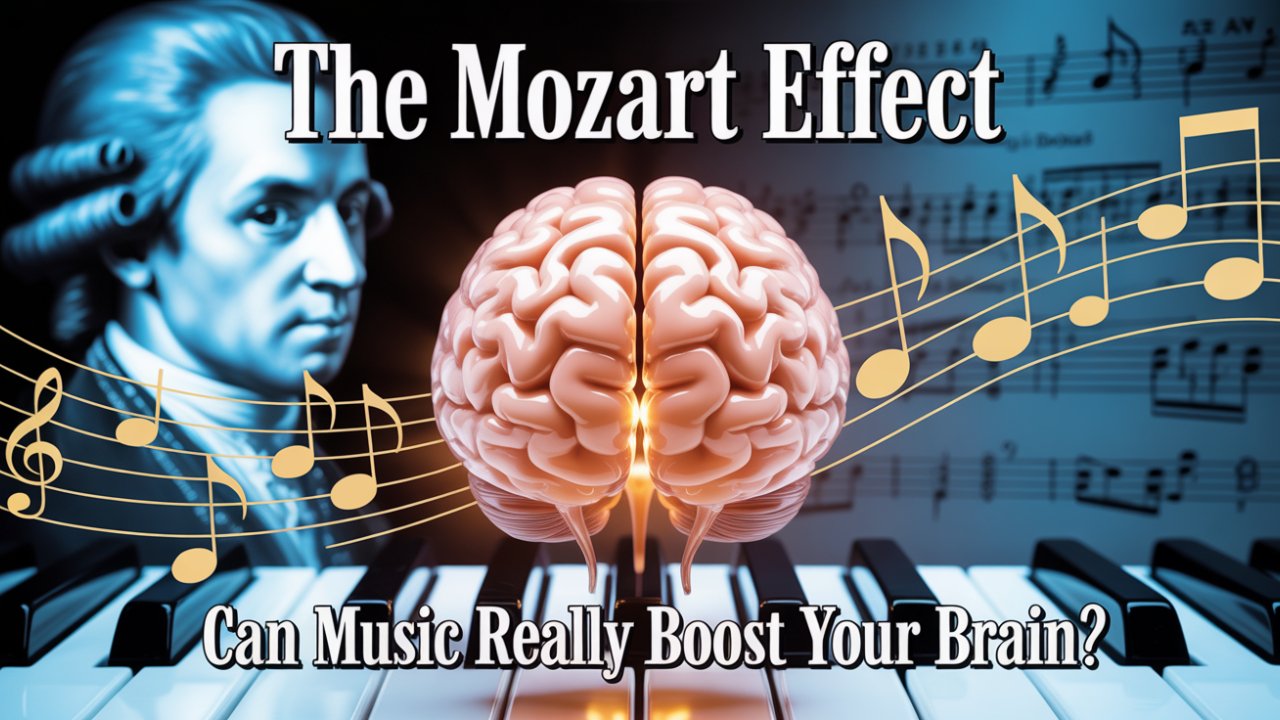Intro
It’s one of the most seductive ideas in pop neuroscience. A simple, elegant promise whispered to ambitious parents for decades: just listen to Mozart, and you can get smarter. The idea has sold millions of albums, launched an entire industry of “smart baby” products, and even shaped government policy. It feels like a perfect life hack, a shortcut to genius hidden in the sublime harmonies of a classical master. The image it conjures is powerful: a child, headphones on, absorbing intelligence from the cascading notes of a sonata, their brain lighting up, their future getting brighter with every bar. It’s a beautiful thought. But is it true?
The claim that listening to Mozart can make you smarter has been a headline for decades, selling millions of CDs and downloads along the way. It’s a concept that is both simple and incredibly appealing. So, is there any truth to it, or is it just one of the most pervasive scientific myths of our time? The answer isn’t a simple yes or no. We’re going to break down the original 1993 experiment, trace the media explosion that followed, and get to the bottom of the controversial science to find the truth behind the Mozart Effect. What we uncover might not be the magic bullet for intelligence we were all promised, but it reveals something far more profound about the powerful relationship between music and the human brain.
The Origin Story: A Spark in a California Lab
Our story starts not in a grand 18th-century concert hall, but in a quiet lab at the University of California, Irvine, back in 1993. Here, three researchers psychologist Frances Rauscher, physicist Gordon Shaw, and their colleague Katherine Ky conducted an experiment that would, almost by accident, capture the world’s attention. They weren’t trying to create a global phenomenon; they were just exploring how the brain processes information, using music as a tool. Their findings were published in Nature, one of the world’s most prestigious scientific journals, which gave their work instant and immense credibility.
The experiment itself was pretty small, but cleverly designed. The researchers took 36 university students and split them into three groups. The first group got the star treatment: ten minutes of Mozart’s Sonata for Two Pianos in D Major, K. 448. This piece was chosen for its complex, non-repetitive structure, which the researchers thought might resonate with firing patterns in the brain. The second group listened to a verbal relaxation tape meant to lower blood pressure. The third group just sat in ten minutes of complete silence.
Right after their ten-minute session, all the students were given a series of tasks. These weren’t general knowledge quizzes. They were very specific tests of spatial-temporal reasoning from the Stanford-Binet Intelligence Scale. Imagine the paper-folding and cutting test: you’re shown a piece of paper being folded and cut, and you have to mentally unfold it to predict the final pattern. This skill is crucial for fields like engineering, architecture, and even chess. It’s all about visualizing and manipulating objects in your mind.
When the researchers analyzed the results, they found something remarkable. The students who sat in silence or listened to the relaxation tape showed no improvement. But the Mozart group showed a significant, measurable jump. Their spatial IQ scores were, on average, 8 to 9 points higher than the other groups. It was a startling result. An eight-point IQ gain is a big deal; it’s a substantial cognitive enhancement. It seemed like they’d found a key that could unlock a specific part of the brain’s potential, and that key was Mozart.
But there was a crucial catch a detail that would be conveniently ignored in the years to come. The effect was incredibly brief. The cognitive boost didn’t last for life, or even for a day. It vanished within 10 to 15 minutes after the music stopped. It was a temporary spark, a brief window of heightened ability that quickly closed.
The original authors were also very clear in their paper about what they had and hadn’t found. They made no claims about boosting general intelligence. The effect was specific to spatial-temporal reasoning. Listening to Mozart didn’t improve verbal skills or long-term memory. It was a precise, narrow, and short-lived phenomenon they’d observed in a small group of college students. In the careful, cautious language of science, they reported their intriguing but limited findings. They had lit a small, controlled fire in a lab. They had no idea it was about to become a global inferno.
The Media Firestorm and the Birth of a Myth
What happened next is a case study in how science can be transformed and distorted by media and commerce. The journey of the Mozart Effect from a small finding in a science journal to a household phrase is a story of hope, hype, and clever marketing. The world was hungry for a simple fix to a complex desire: making ourselves and our kids smarter. And the media was happy to serve it up.
The original study’s nuance was the first casualty. The key details that the effect was temporary, lasted only 15 minutes, was found only in college students, and applied specifically to spatial reasoning were just chopped out of the story. “Mozart Makes You Smarter” has a much better ring to it than “Listening to Mozart Temporarily Enhances Spatial-Temporal Reasoning in Undergraduates.”
The message that spread was simple, powerful, and deeply appealing. It quickly morphed into the idea that just being around classical music could create a lasting boost to intelligence. The leap from college students to infants was made almost immediately, without a single shred of evidence. If it worked on adults, the thinking went, imagine what it could do for a developing baby’s brain! Soon, the myth was everywhere. Parenting magazines and morning talk shows buzzed with the promise of the Mozart Effect. Expectant mothers were told to put headphones on their pregnant bellies. A whole industry bloomed overnight. There were “Mozart for Babies” CDs, “Smart Baby” toys playing classical tunes, and books promising to unlock your child’s genius, all based on a wild over-simplification of the original study.
The craze hit its peak in 1998, when Georgia’s governor, Zell Miller, became the myth’s most powerful champion. He famously played a recording of Beethoven’s “Ode to Joy” to the state legislature and asked, “Now, don’t you feel smarter already?” He went on to propose allocating $105,000 of the state budget each year so that every child born in Georgia would receive a classical music CD. Soon, new parents in Georgia were being sent home from the hospital with a CD titled “Build Your Baby’s Brain Through the Power of Music.” Florida followed suit, passing a law that required state-funded childcare centers to play classical music every day. The Mozart Effect had gone from a tentative hypothesis to public policy in just five years.
Amid this global craze, the original researchers watched in alarm. Frances Rauscher, in particular, was dismayed by the circus her work had created. She repeatedly tried to correct the record. In interviews, she stressed her findings were limited, saying, “We made no claim that listening to Mozart makes you smarter.” She clarified that the effect was specific to spatial-temporal tasks and pointed out there was zero evidence for any effect on infants. When asked about the Georgia program, her response was diplomatic but clear: “I don’t think it can hurt… I do think the money could be better spent on music education programs.”
But her clarifications were a whisper in a hurricane of hype. The myth was just too good to die. It offered an easy path to cognitive enhancement. You didn’t need to study or practice. You just had to press play. The Mozart Effect was no longer a scientific finding; it was a cultural phenomenon and a multi-million dollar business. The problem was, its foundation was built on a misreading of science, and the scientific community was about to put that foundation to the test.
The Scientific Reckoning and the Power of Replication
Science has a powerful, built-in self-correction tool: replication. A single, spectacular finding isn’t enough. For a discovery to be accepted, other researchers must be able to do the same experiment and get the same results. It’s the bedrock of scientific credibility. And so, as the Mozart Effect conquered pop culture, scientists around the world started trying to replicate the 1993 study. What they found or rather, what they didn’t find would change the whole story.
One of the biggest blows came in 1999, in the very same journal that started it all: Nature. A psychologist named Christopher Chabris conducted a meta-analysis, which is basically a study of studies. He gathered data from 16 different attempts to replicate the Mozart Effect, combining the results from over 700 participants.
By pooling all this data, he got a much clearer picture. His conclusion was damning. When all the results were averaged out, the huge 8-point IQ gain from the original study vanished. The meta-analysis found a tiny, statistically insignificant effect of just 1.4 IQ points, which he argued was likely not a real effect at all. He titled his paper, “Prelude or requiem for the ‘Mozart effect’?”, suggesting the idea was dead.
Many other studies came to the same conclusion. Researchers like Kenneth Steele faithfully replicated the original work, using the same Mozart sonata and the same cognitive tests. Their results, published in Psychological Science, were clear: they found no statistically significant Mozart Effect. They concluded there was little evidence to support basing educational programs on its existence.
Of course, science is a debate. Rauscher and her colleagues defended their work, arguing that many labs failing to replicate it weren’t using the right procedures or were testing for the wrong kind of spatial reasoning. But even this defense didn’t explain why direct replications were still failing to find a significant effect.
Over time, a consensus formed in the cognitive neuroscience community. While a handful of studies found a small effect, the overwhelming majority did not. The Mozart Effect, as the world understood it, was largely an illusion. The effect was inconsistent, tiny when it did appear, and incredibly hard to reproduce. The scientific reckoning had arrived. So the question that remained was, if it wasn’t a fluke, what was actually happening in that lab back in 1993? What had they really discovered?
It’s a fascinating turn, isn’t it? The science took a completely different direction than the headlines. What’s the most outrageous ‘brain hack’ you’ve ever heard of? Let me know in the comments below. I’m genuinely curious to read about the other myths and quick fixes that are out there.
A New Theory Emerges: The Arousal and Mood Hypothesis
As the idea of a magical property in Mozart’s music crumbled, a new, more plausible explanation took its place. Scientists began to ask a different question: what if the effect had nothing to do with Mozart at all? What if it was simply about how the music made the listeners feel?
This led to what is now the most widely accepted explanation: the Arousal and Mood Hypothesis. Championed by researchers like E. Glenn Schellenberg, this theory says the cognitive boost seen in 1993 wasn’t a direct effect of music on the brain’s spatial centers. Instead, it was an indirect effect, caused by the listener’s emotional state.
The hypothesis is beautifully simple. Listening to music you enjoy can elevate your mood and increase your arousal your level of alertness and engagement. Being in this more positive, energized state can temporarily improve your performance on cognitive tasks.
Essentially, the Mozart sonata didn’t act like a key unlocking a specific door in the brain. It acted more like a cognitive cup of coffee. It gave the students a temporary jolt of alertness and pleasure, and this positive mental state is what helped them perform slightly better on the difficult paper-folding task. The students in the other groups didn’t get this boost. Silence was neutral, and the relaxation tape was designed to lower their arousal, which is not the ideal state for a complex mental puzzle.
The genius of this hypothesis is that it makes a testable prediction: if the theory is correct, then any stimulus that a person enjoys and finds engaging should be able to produce a “Mozart Effect.” It doesn’t have to be Mozart. It doesn’t even have to be music.
And that’s exactly what researchers found. In one clever study, participants could listen to Mozart or a narrated short story by horror author Stephen King. The results were striking. For people who preferred Mozart, his music led to better performance. But for the Stephen King fans, the suspenseful story led to better performance than Mozart.
Another study compared Mozart to upbeat British pop music by the band Blur. They found that participants who enjoyed Blur showed the same performance boost as those who enjoyed Mozart. The key factor wasn’t the genre; it was the listener’s preference and the positive mood that followed.
These findings completely changed the conversation. The focus moved from the mystical properties of Mozart’s music to the subjective experience of the listener. The Mozart Effect wasn’t a universal phenomenon. It was an artifact of enjoyment. If you like Mozart, it might perk you up and help you focus for a few minutes. If you prefer pop, rock, or a good podcast, that will likely do the exact same thing. The magic wasn’t in the music; it was in the mood.
The Real Music-Brain Connection: Active Training vs. Passive Listening
So, the dream of boosting your IQ by just pressing ‘play’ might be a fantasy. But the story doesn’t end there. In fact, this is where the real connection between music and the brain begins. Debunking the myth cleared the way for scientists to explore a much more powerful and lasting connection one that requires more than just headphones. The critical difference is between passive listening and active musical training.
Passive listening is what the Mozart Effect was all about. As we’ve seen, its benefits are mostly temporary and tied to mood. Active musical training, on the other hand, is learning to play an instrument. It’s a long-term, effortful activity that requires intense focus and coordination. And the evidence is overwhelming: this kind of active engagement with music doesn’t just give you a temporary mood boost; it can fundamentally change your brain’s structure and function.
This process is called neuroplasticity the brain’s ability to reorganize itself by forming new connections. When you learn an instrument, you’re giving your brain an intense, full-body workout. You have to read music, translate those symbols into precise finger movements, and listen intently to the sounds you’re producing to adjust in real-time.
Brain imaging studies show that this training leads to significant, observable changes. The brains of musicians are different. Areas for motor control, hearing, and coordination are often larger and more active. The corpus callosum, the nerve bundle connecting the brain’s two hemispheres, has been found to be larger in musicians, suggesting better communication between them.
These structural changes lead to a remarkable array of cognitive benefits that go far beyond music. This is what scientists call “far transfer.” While the Mozart Effect offered a tiny, fleeting bump in one skill, musical training is linked to broad and lasting enhancements across many areas.
For example, studies have linked musical training in children with improved verbal memory and reading ability. Other research shows that children with musical training have better executive functions high-level skills like problem-solving, planning, and task-switching. Some long-term studies have even suggested that learning an instrument as a child can predict higher academic performance and IQ scores later in life. The key is that this isn’t magic. It’s likely that the discipline, focus, and complex skills developed through years of practice are what contribute to these broader gains.
And the benefits aren’t just for the young. Research shows that playing music can help maintain cognitive health in older adults, building a “cognitive reserve” that may help protect against age-related decline.
This is the real, science-backed story. It’s not a simple hack. It’s a testament to the power of dedicated practice. While passively listening to music we enjoy can reduce stress and improve our mood, it doesn’t re-wire our brains for higher intelligence. For that, you have to pick up an instrument. You have to do the work. The true gift of music isn’t that it can make you smarter effortlessly; it’s that it provides a path to train your brain in one of the most comprehensive ways possible.
So, let’s go back to our initial question: can listening to Mozart really boost your brain? The journey to the answer has taken us from a small California study to the halls of government, through a media firestorm, and into the world of rigorous science. And the conclusion is clear.
The “Mozart Effect,” as most people know it the idea that listening to classical music will raise your IQ is a myth. It was born from a dramatic misreading of a single study that showed a very specific, tiny, and temporary effect. The global phenomenon that followed was fueled more by wishful thinking than by solid science. The scientific community, through years of research, debunked the myth and replaced it with a far more plausible explanation: the arousal and mood hypothesis. The temporary boost isn’t about Mozart; it’s about the pleasure and alertness that any enjoyable activity can provide.
But to say the Mozart Effect is a myth isn’t to say music is powerless. The opposite is true. By chasing down this myth, science found a deeper truth. The real power of music on the brain comes not from passive listening, but from active participation. Learning to play an instrument is a potent form of cognitive training, rewiring the brain and enhancing skills from memory to problem-solving.
In the end, the legacy of the Mozart Effect is a cautionary tale about the gap between science and public understanding. It shows how much we want simple solutions and how quickly nuance gets lost. But it also guided us toward a more powerful truth. Music isn’t a shortcut to genius. It’s something far more valuable. It’s a source of joy that can lift our mood and sharpen our focus. And for those who actively engage with it, it’s a tool for building a better, stronger, and more connected brain. You don’t need Mozart to make you smarter, but a life filled with music is, without a doubt, a richer one.
If you found this deep dive into the science behind the headlines useful, and you want to learn more about how your brain really works, consider subscribing to the channel and turning on notifications. We break down the neuroscience behind myths, trends, and human behavior every week. Thanks for watching.





